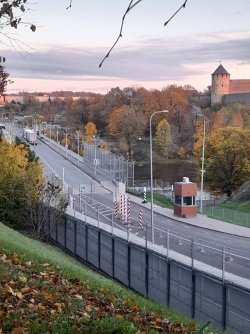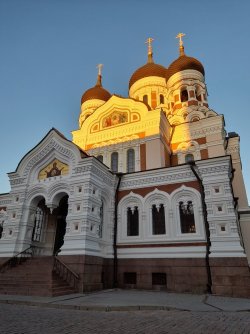kileskus
Member
- Joined
- Jan 20, 2019
- Posts
- 155
Narva
From Tartu I took a bus directly to Narva in eastern Estonia on the border with Russia. This is the 3rd largest city in Estonia, although a very Russian one in that it is predominantly russophone and has a high proportion of Russian migrants on work visas and Estonian-born Russians.
In 1219 King Waldemar II of Denmark invaded Estonia (after a few previous failed invasions) and captured a section of northern Estonia including Tallinn and Narva. Legend has it that it was during the battle in Tallinn that a red-and-white banner fell from the sky, and its sudden appearance gave the Danes renewed vigour that helped them win that battle. They continued to use that banner in their battles and it eventually became the Danish flag. Narva was the eastern-most edge of this Danish territory so they built a fortress here to pre-empt conflict with Novgorod and/or Muscovy.

Hermann Castle, initially built by the Danes and expanded by the Livonian Order, with bastions built by the Swedes. It houses the local museum.
The Danes then sold their territory to the Livonian Order, a branch of the Teutonic Order. Prince Ivan III of Moscow was not happy with the Order being at his doorstep so he built a fortress of his own just across the Narva River. The fort/town he built was named Ivangorod after him.

After the Livonian Wars, the LO dissolved and Livonia became part of the Polish-Lithuanian Commonwealth before being captured by Muscovy. Narva became a key town in the Great Northern War between Sweden and Russia, falling to the Swedes under Charles XII before being retaken by Russia under Peter the Great. The Swedes built bastions around the city with tunnels underneath them. You can take a tour of Victoria bastion’s tunnels. I unfortunately visited on a Monday where the tunnels and the castle/museum were closed, and as I only had one full day left I wanted to go to Tallinn instead.

From here, around a bend in the river, the two landmarks look remarkably close. I spent some time sitting there imagining Narva bustling with trade, soldiers stationed on the castle walls, while the tsar's sombre soldiers built their fortress. Ivan had the architect blinded after the fort was built so that he would never design a structure of this beauty again. (Ivan III's grandson, Ivan IV aka the Terrible would do the same to the architect of St Basil's Cathedral. Risky business being the tsar's architect I think is the moral of the story.) Then the Livonians built that central white tower with the red roof so they could peek into the Ivangorod fort, so then Ivan had taller walls built (the ones you see here) and won the little battle of vantage point supremacy. The knee-deep fishermen to my right had probably caught quite a few by the time I finished this daydream.

Being a major border crossing point with Russia, security along the bridge to Ivangorod has increased. I was told by a local in Tallinn that NATO had sent more troops to Narva, though I haven’t verified this and didn’t see any NATO troops myself.

The crossing is usually busier than this. I made this trip in Oct/Nov last year; in Aug the Russians had practically closed the crossing and greatly reduced the traffic allowed across it because the Estonians had removed a Soviet tank along that road on the Narva side that memorialised the liberation of the city from the naz_s. In response, the Russians put up a memorial Soviet tank on their side of the road and "indefinitely" closed the border checkpoint.

Estonians are not very religious and they pride themselves on their relative secularism. The majority denomination, at around 16%, is Orthodox Christianity, followed by Lutheranism at around 12%. Some still even adhere to old Estonian faith, as you will find out at the national museum in Tartu. Narva, having been under Russian rule and with its current highly Russian population, has quite a few Orthodox churches.

Apologies for the bad angle. It is the only church photo I took
Late that afternoon I took the train to Tallinn. On the road between Narva and Tallinn are two towns I had wanted to stop by: Rakvere for its castle and Püssi out of ahem purely ethnographic interest, but I had spent too long in Narva and the train schedule only allowed me one stop. It came down to a coin toss.

Rakvere Castle
Outside the castle is a large statue of an aurochs, a widely distributed species of wild ox that went extinct in the 17th century due to human agricultural activity.

There are attempts to bring it back from extinction for land restoration purposes
In summary, Narva is good for a day trip if you’re interested in medieval history, but visit on Wed-Sun. If you have more time and a car there are a couple places between Tallinn and Narva you can visit, castles, parks, waterfalls. Rakvere castle was nice to look at but closed the day I went, so looking back I do regret that the coin hadn’t flipped the other way.
From Tartu I took a bus directly to Narva in eastern Estonia on the border with Russia. This is the 3rd largest city in Estonia, although a very Russian one in that it is predominantly russophone and has a high proportion of Russian migrants on work visas and Estonian-born Russians.
In 1219 King Waldemar II of Denmark invaded Estonia (after a few previous failed invasions) and captured a section of northern Estonia including Tallinn and Narva. Legend has it that it was during the battle in Tallinn that a red-and-white banner fell from the sky, and its sudden appearance gave the Danes renewed vigour that helped them win that battle. They continued to use that banner in their battles and it eventually became the Danish flag. Narva was the eastern-most edge of this Danish territory so they built a fortress here to pre-empt conflict with Novgorod and/or Muscovy.

Hermann Castle, initially built by the Danes and expanded by the Livonian Order, with bastions built by the Swedes. It houses the local museum.
The Danes then sold their territory to the Livonian Order, a branch of the Teutonic Order. Prince Ivan III of Moscow was not happy with the Order being at his doorstep so he built a fortress of his own just across the Narva River. The fort/town he built was named Ivangorod after him.

After the Livonian Wars, the LO dissolved and Livonia became part of the Polish-Lithuanian Commonwealth before being captured by Muscovy. Narva became a key town in the Great Northern War between Sweden and Russia, falling to the Swedes under Charles XII before being retaken by Russia under Peter the Great. The Swedes built bastions around the city with tunnels underneath them. You can take a tour of Victoria bastion’s tunnels. I unfortunately visited on a Monday where the tunnels and the castle/museum were closed, and as I only had one full day left I wanted to go to Tallinn instead.

From here, around a bend in the river, the two landmarks look remarkably close. I spent some time sitting there imagining Narva bustling with trade, soldiers stationed on the castle walls, while the tsar's sombre soldiers built their fortress. Ivan had the architect blinded after the fort was built so that he would never design a structure of this beauty again. (Ivan III's grandson, Ivan IV aka the Terrible would do the same to the architect of St Basil's Cathedral. Risky business being the tsar's architect I think is the moral of the story.) Then the Livonians built that central white tower with the red roof so they could peek into the Ivangorod fort, so then Ivan had taller walls built (the ones you see here) and won the little battle of vantage point supremacy. The knee-deep fishermen to my right had probably caught quite a few by the time I finished this daydream.

Being a major border crossing point with Russia, security along the bridge to Ivangorod has increased. I was told by a local in Tallinn that NATO had sent more troops to Narva, though I haven’t verified this and didn’t see any NATO troops myself.

The crossing is usually busier than this. I made this trip in Oct/Nov last year; in Aug the Russians had practically closed the crossing and greatly reduced the traffic allowed across it because the Estonians had removed a Soviet tank along that road on the Narva side that memorialised the liberation of the city from the naz_s. In response, the Russians put up a memorial Soviet tank on their side of the road and "indefinitely" closed the border checkpoint.

Estonians are not very religious and they pride themselves on their relative secularism. The majority denomination, at around 16%, is Orthodox Christianity, followed by Lutheranism at around 12%. Some still even adhere to old Estonian faith, as you will find out at the national museum in Tartu. Narva, having been under Russian rule and with its current highly Russian population, has quite a few Orthodox churches.

Apologies for the bad angle. It is the only church photo I took
Late that afternoon I took the train to Tallinn. On the road between Narva and Tallinn are two towns I had wanted to stop by: Rakvere for its castle and Püssi out of ahem purely ethnographic interest, but I had spent too long in Narva and the train schedule only allowed me one stop. It came down to a coin toss.

Rakvere Castle
Outside the castle is a large statue of an aurochs, a widely distributed species of wild ox that went extinct in the 17th century due to human agricultural activity.

There are attempts to bring it back from extinction for land restoration purposes
In summary, Narva is good for a day trip if you’re interested in medieval history, but visit on Wed-Sun. If you have more time and a car there are a couple places between Tallinn and Narva you can visit, castles, parks, waterfalls. Rakvere castle was nice to look at but closed the day I went, so looking back I do regret that the coin hadn’t flipped the other way.


















